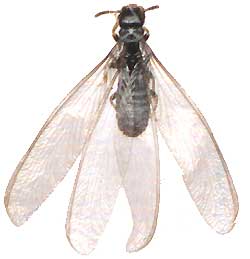

English Name: Subterranean
Termite
Family: Rhinotermitidae
Genus: ?
Species: ?
Someone tore down an old building and I got the shattered wood to use in my campfires. One day I picked up a half-rotten piece of lumber, broke it in half, and saw what's shown in the above image. These are wingless worker termites only about 1/16th of an inch long (4 mm).
 A few weeks later, in April, one day I looked out my door and there was a cloud of hundreds of winged adult termites flying up from the ground, their wings glistening in the sunlight. At the left you see one of them. So, how do I know that this isn't a flying ant?
A few weeks later, in April, one day I looked out my door and there was a cloud of hundreds of winged adult termites flying up from the ground, their wings glistening in the sunlight. At the left you see one of them. So, how do I know that this isn't a flying ant?
The entire body is thick (ant bodies have a very slender constriction between the thorax and the abdomen)
The four wings are about equal in length (among ants, the forewings are longer than the hindwings)
In North America, the termite order Isoptera is represented by four families. Two of these, the Rotten-wood Termite Family (Hodotermitidae) and the Desert Termite Family (Termitidae), occur only in the West. Therefore, if you live in Eastern North America, you can have the fun of distinguishing between the two remaining families, which is easy to do. The termite shown above is in the Subterranean Termite Family (Rhinotermitidae) and the other family is the Dry-wood Termite Family (Kolotermitidae). In the above picture notice that two strong veins extend the entire lengths of all four wings, along the front margins. At no point do you see cross-veins connecting the two long veins. That makes it a Subterranean Termite. If it were a Dry-wood Termite, you'd very clearly see several cross-veins connecting the two strong veins.
Termites, like ants and bees, have complex social structures. There are males, queens, workers and soldiers, which all look a little different.